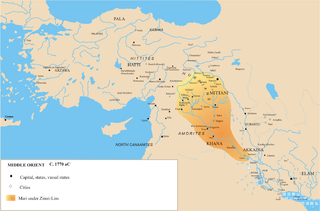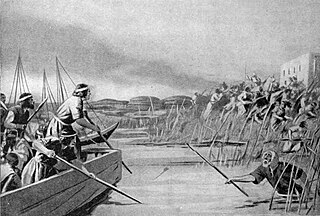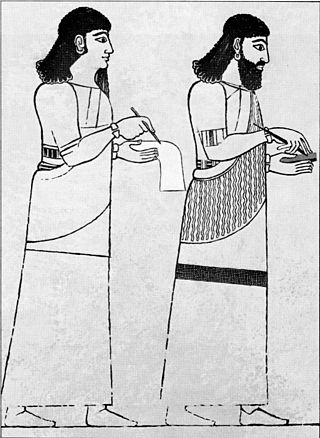Sippar was an ancient Near Eastern Sumerian and later Babylonian city on the east bank of the Euphrates river. Its tell is located at the site of modern Tell Abu Habbah near Yusufiyah in Iraq's Baghdad Governorate, some 69 km (43 mi) north of Babylon and 30 km (19 mi) southwest of Baghdad. The city's ancient name, Sippar, could also refer to its sister city, Sippar-Amnanum ; a more specific designation for the city here referred to as Sippar was Sippar-Yaḫrurum (Sippar-Jaḫrurum). The name comes from the Amorite Yaḫrurum tribe that lived in the area along with the Amorite Amnanum tribe. In Sippar was the site where the Babylonian Map of the World was found.
Isin (Sumerian: 𒉌𒋛𒅔𒆠, romanized: I3-si-inki, modern Arabic: Ishan al-Bahriyat) is an archaeological site in Al-Qādisiyyah Governorate, Iraq which was the location of the Ancient Near East city of Isin, occupied from the late 4th millennium Uruk period up until at least the late 1st millennium BC Neo-Babylonian period. It lies about 40 km (25 mi) southeast of the modern city of Al Diwaniyah.

Samsu-iluna was the seventh king of the founding Amorite dynasty of Babylon. His reign is estimated from 1749 BC to 1712 BC, or from 1686 to 1648 BC. He was the son and successor of Hammurabi by an unknown mother. His reign was marked by the violent uprisings of areas conquered by his father and the abandonment of several important cities.
Bad-tibira, "Wall of the Copper Worker(s)", or "Fortress of the Smiths", identified as modern Tell al-Madineh, between Ash Shatrah and Tell as-Senkereh and 33 kilometers northeast of ancient Girsu in southern Iraq, was an ancient Sumerian city on the Iturungal canal, which appears among antediluvian cities in the Sumerian King List. Its Akkadian name was Dûr-gurgurri. It was also called Παντιβίβλος (Pantibiblos) by Greek authors such as Berossus, transmitted by Abydenus and Apollodorus. This may reflect another version of the city's name, Patibira, "Canal of the Smiths".

Utu-hengal, also written Utu-heg̃al, Utu-heĝal, and sometimes transcribed as Utu-hegal, Utu-hejal, Utu-Khengal, was one of the first native kings of Sumer after two hundred years of Akkadian and Gutian rule, and was at the origin of the foundation of the Third Dynasty of Ur by his son-in-law Ur-Nammu. He was officially "King of Uruk" in his inscriptions, and is therefore considered as the founder, and only member, of the "Fifth dynasty of Uruk".

Zimri-Lim was in the Middle Bronze Age the king of Mari.
Kazalla or Kazallu (Ka-zal-luki) is the name given in Akkadian sources to a city in the ancient Near East whose locations is unknown. Its god is Numushda with his consort Namrat. There are indications that the god Lugal-awak also lived in Kazallu.
Kesh was an ancient Sumerian city and religious site, whose patron goddess was Ninhursag. It was included on the "city seals" found at Jemdat Nasr. These seals sparked the theory at an Early Dynastic Kengir League control Sumer at that time. Its location is uncertain; some of the possible sites put forth include Al-Ubaid, near Ur, or Tell al-Wilayah near Adab or Abu Salabikh or even Tell Jidr though the consensus is now with Tell al-Wilayah or Tulul al-Baqarat. The city is known to be located near to the ancient city of Irisaĝrig and was under the control of that city. According to a riddle from Early Dynastic times, there was a Kesh Canal, which Adab was on.
Haradum, modern Khirbit ed-Diniye, in Al Anbar Governorate Iraq, was an ancient Near East city on the middle Euphrates about 90 kilometers southeast of Mari. It was part of the ancient region of Suhum. The name of the town meant "the place where one stands watch". It was strategically placed on the border of four kingdoms, Eshnunna, Ekallatum, Mari and Babylon and is thought to have been first settled by Eshnunna. It is known that a toolboth was established on the river and a toll collected.

The First Sealand dynasty (URU.KÙKI), or the 2nd Dynasty of Babylon, very speculatively c. 1732–1460 BC, is an enigmatic series of kings attested to primarily in laconic references in the king lists A and B, and as contemporaries recorded on the Assyrian Synchronistic king list A.117. Initially it was named the "Dynasty of the Country of the Sea" with Sealand later becoming customary.

Nabû-šumu-libūr, inscribed dAG.MU-li-bur or dna-bi-um-MU-li-bur, meaning "O Nabû, may (my) progeny / the son stay in good health," was the 11th and last king of the 2nd Dynasty of Isin, the 4th Dynasty of Babylon. He ruled during a period of instability due to incursions of Aramean nomadic tribesmen in Northwest Babylonia.

Īter-pīša, inscribed in cuneiform as i-te-er-pi/pi4-ša and meaning "Her command is surpassing", c. 1833–1831 BC (MC), was the 12th king of Isin during the Old Babylonian period. The Sumerian King List tells us that "the divine Īter-pīša ruled for 4 years." The Ur-Isin King List which was written in the 4th year of the reign of Damiq-ilišu gives a reign of just 3 years. His relationships with his predecessor and successor are uncertain and his reign falls during a period of general decline in the fortunes of the dynasty.

An eduba is a scribal school for the Sumerian language. The eduba was the institution that trained and educated young scribes in ancient Mesopotamia during the late third or early second millennium BCE. Most of the information known about edubas comes from cuneiform texts dating to the Old Babylonian period.
Malgium is an ancient Mesopotamian city tentatively identified as Tell Yassir which thrived especially in the Middle Bronze Age, ca. 2000 BC - 1600 BC. Malgium formed a small city-state in an area where the edges of the territories controlled by Larsa, Babylon and Elam converged. Inscribed in cuneiform as ma-al-gi-imKI, its chief deities were Ea and Damkina. A temple of Ulmašītum is known to have been there. There was also a temple to the goddess Bēlet-ilī called Ekitusgestu as well as a temple to the god Anum.
Rapiqum, ra-bi-qa-wiKI, was a city of the ancient Near East. The city was located in the north of Mesopotamia, probably on the eastern bank of the Euphrates River, in modern Iraq. It is firmly attested from early in the 2nd Millennium BC until early in the 1st Millennium BC.
Lagaba was a city in the historical region of southern Mesopotamia. It is the place of origin of many illicitly excavated clay tablets, all in Old Babylonian. More than 400 tablets are known to have originated there. Tablets from Lagaba are kept in various collections around the world, among which
Tell Sifr is an ancient Near East archaeological site in Dhi Qar Governorate Iraq generally thought to be the small ancient town of Kutalla. It lies about nine miles east from the ancient city of Larsa. The city lay on a branch of the ancient Iturungal canal that also runs to Bad-tibira.
"Two effluents took off from the left bank of the Iturungal, the Id-Ninaki-gen-a, which over Bzeikh (Zabalam) flowed to Telloh (Girsu), al Hibba, and Surghul (Nina), and an anonymous branch which takes off from a point north of Mansuriyah, passes well to the east of Madi-nah (Bäd-tibira), and continues south-east down to a small mound also called Madi-nah. A branch takes off from the right bank and runs to Tell Sifr (Kutalla)."
Šubula (Shubula) was a Mesopotamian god. He was associated with the underworld, and commonly appears in association with Nergal, Ishum, Laṣ and other deities of similar character. He was worshiped in small settlements such as Ṣupur-Šubula and Lagaba, likely located in the proximity of Kutha, but also in Susa and Uruk.
Ikšudum or Yakšudum was a Mesopotamian god worshiped in the kingdom of Mari, possibly a deified ancestor. He was closely associated with Lagamal. A possibly related deity is also listed among the hounds of Marduk in the god list An = Anum. Texts from Mari mention a ritual procession of Ikšudum and Lagamal. The pair was also invoked in oath formulas.
The Manana Dynasty ruled over an ancient Near East state in Mesopotamia during Isin-Larsa period in the chaotic time after the fall of the Ur III Empire. In the power vacumn, Mesopotamia became a struggle for power between city-states, some like Isin, Larsa, and later Babylon would rise while others, like the state ruled by the Manana Dynasty, faded from history.








